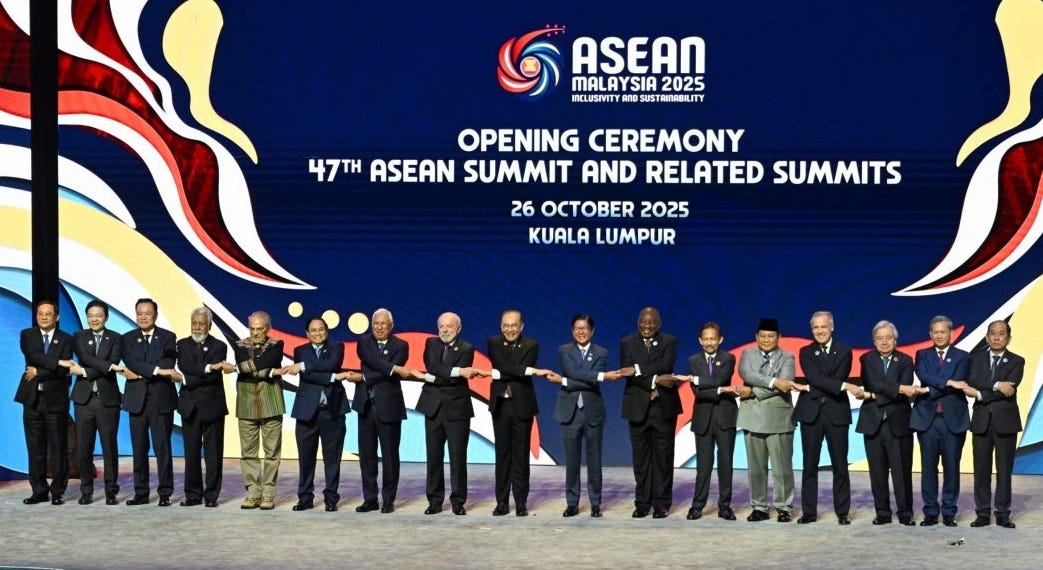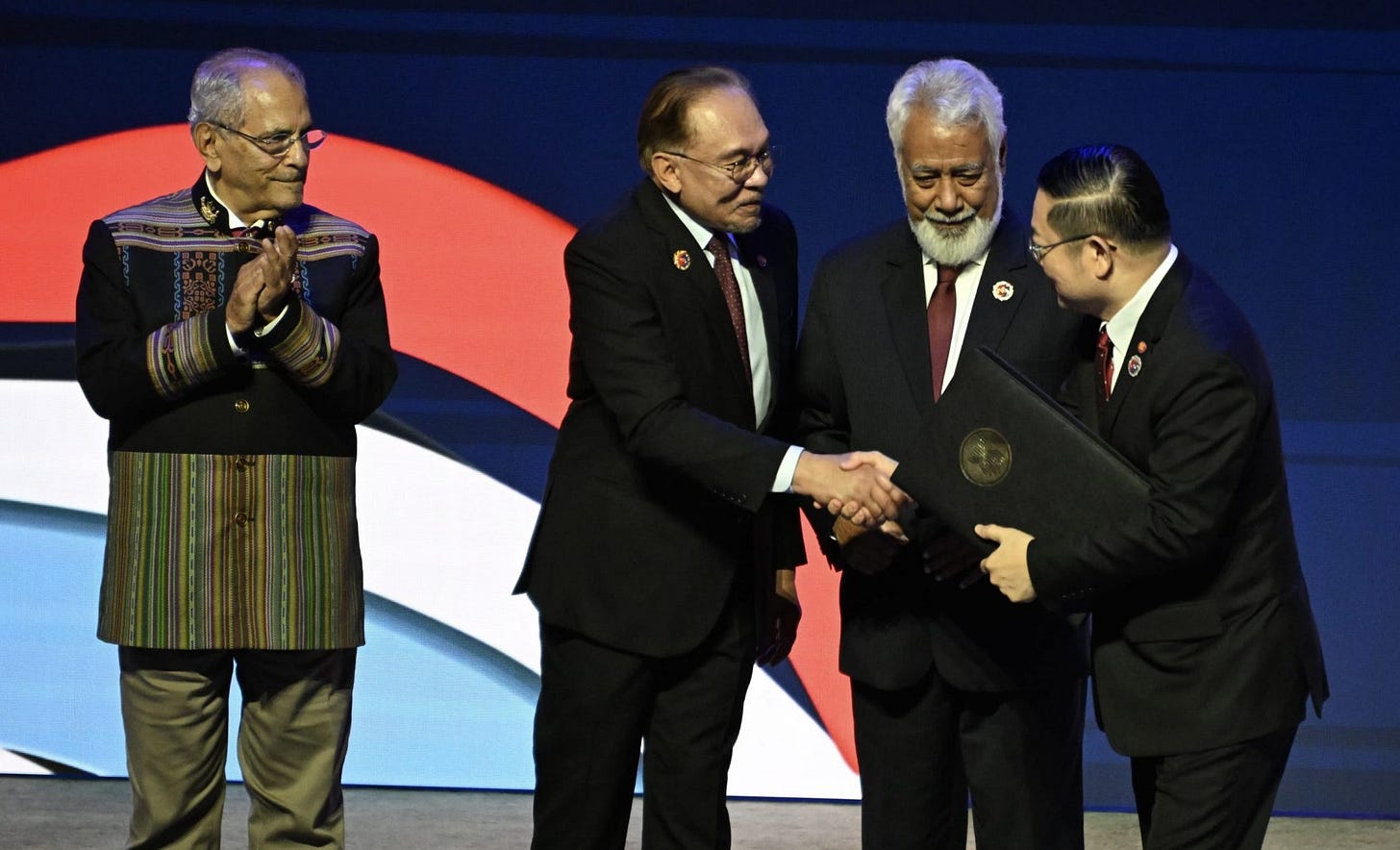🌏 Key outcomes of the 47th ASEAN Summit in Malaysia 🇲🇾
Bloc strengthens its diplomatic, economic, and social agenda in a fast-changing global landscape

The Main Takeaway 🎯
ASEAN chair Malaysia hosted the 47th ASEAN Summit and related meetings on October 26–28 in Kuala Lumpur.
The summit’s theme, “Inclusivity and Sustainability,” highlights regional priorities for inclusive growth and sustainable development, amid global uncertainty and rising tensions.
Leaders from ASEAN and partner countries attended to discuss various topics, including the South China Sea issue, Myanmar’s conflict, as well as trade and economic cooperations.
Why It’s on Our Radar 🔍
ASEAN needs to focus on several key issues, including:
Major geopolitical conflicts—such as in Palestine-Israel, Russia-Ukraine, Myanmar, and parts of Africa.
Territorial disputes in the South China Sea have intensified in recent decades.
Since April 2025, the US has implemented a new reciprocal tariff policy for its trading partners.
The ongoing trade war between the US and China.
A territorial conflict between Thailand and Cambodia escalated on July 24, 2025, before both sides agreed to a ceasefire on July 28, 2025.
Timor-Leste applied to join ASEAN in 2011 and was granted observer status in 2022.
Why It Matters ⚠️
These issues may impact ASEAN’s stability, especially in:
Energy: Tensions involving major oil and gas exporters in the Middle East and Russia may disturb global supply chains, triggering inflation, higher energy prices, and more investment costs.
Agriculture: As a key exporter of wheat and sunflower oil, disruptions in Ukraine have pushed up global commodity prices and fueled inflation.
Territories: South China Sea disputes involving China, Taiwan, and several ASEAN countries (Vietnam, the Philippines, Malaysia, Thailand, Brunei Darussalam, Indonesia) have caused regional instability due to overlapping claims and exclusive economic zones.
Export: The US reciprocal tariff policy and its trade war with China may reduce ASEAN exports to the US and prompt the region to seek a balance in trade with both powers.
Regional stability: The Thailand–Cambodia conflict challenges ASEAN centrality and regional stability, urging ASEAN to take a strategic approach to resolve it.
Timor-Leste membership: Since 2023, ASEAN has adopted a roadmap for Timor-Leste’s full membership, expected to boost trade, investment, education, regional integration, and international presence to improve the economy.

The Big Picture 📸
Several meetings were held during the summit, including:
ASEAN Summit – among ASEAN member states, to discuss regional peace, security, stability, and prosperity through an inclusive, forward-looking, and sustainable regional framework
ASEAN Plus One Summit – with partner countries (Australia, China, India, Japan, South Korea, Russia, and the US), to discuss ASEAN’s future direction and exchange views on regional and global issues, including cooperation in trade, investment, supply chains, digitalization, and renewable energy.
ASEAN Plus Three Summit – with China, Japan, and South Korea- reviews the progress under the ASEAN Plus Three cooperation framework and sets future directions focused on the digital economy, maritime cooperation, energy, connectivity, health, and education.
ASEAN–UN Summit – between ASEAN and the UN, regarding the synergies between ASEAN Community Vision 2045 and the UN 2030 Agenda for Sustainable Development.
ASEAN–New Zealand Summit – marking 50 years of partnership, and establishing the ASEAN - New Zealand strategic partnership.
East Asia Summit – with Australia, China, India, Japan, South Korea, New Zealand, Russia, and the US, to review the progress of East Asia Summit cooperation on its 20th anniversary, focusing on strategic, political, and economic issues to promote peace, stability, and prosperity in the region.
Why This Hits Home ❤️
ASEAN’s population reached over 682 million in 2024 and is projected to surpass 700 million by 2025, accounting for approximately 8.5% of the global total. (ASEAN Stats)
ASEAN is the world’s fifth-largest economy, with a collective GDP of approximately USD 3.8 trillion, growing at 4.5% in 2024 and projected to rise by 4.7% in 2025. (ASEAN Economic Community)
The summits aim to strengthen ASEAN’s internal unity, integration, and connectivity through the Five-Point Consensus, enhancing regional stability, security, and the economy while boosting external trade, investment, and cooperation for mutual growth.
What’s at Stake ⚖️
Tensions in the Middle East and the Russia-Ukraine war have disrupted global oil and gas supplies. The Houthi blockade in the Red Sea and sanctions on Russian oil have raised prices and import costs for ASEAN.
The South China Sea holds about 11 billion barrels of untapped oil and 190 trillion cubic feet of natural gas, sparking disputes among China, Taiwan, and ASEAN countries. This led to the 1982 UNCLOS, ASEAN’s 1992 Declaration on the South China Sea, and ongoing ASEAN-China Code of Conduct talks, which are expected to conclude in 2026.
ASEAN’s total goods trade reached USD 3.5 trillion globally, but the US reciprocal tariffs and its trade war with China may reduce this number, driving the region to seek more trade within ASEAN and other regions. (ASEAN Economic Community)
Thailand lost over USD 300 million in property damage and evacuation costs during its conflict with Cambodia, which also halted the countries’ goal of reaching USD 15 billion in trade by 2025. (Ministry of Finance)
Cambodia’s tourism sector was hit hard and expected to drop after the 11th-century Preah Vihear Temple was severely damaged in the border clash. Tourism contributed USD 3.63 billion, or 9.4% of GDP, in 2024. (Ministry of Tourism)
Myanmar’s conflict and the March 28 earthquake have caused approximately USD 11 million in infrastructure damage, equivalent to 14% of its GDP, which is expected to shrink by 2.5% in 2025/2026. (The World Bank)
As ASEAN’s youngest member, Timor-Leste has the lowest GDP, at nearly USD 2 billion in 2024, and therefore requires more ASEAN support, particularly through investment, to improve its economy. (Trading Economics)

47th ASEAN Summit Key Outcomes
There are 80 outcome documents adopted during the three-day summit, including:
ASEAN-RELATED OUTCOMES:
Timor-Leste joins ASEAN as the 11th member state:
After 14 years of waiting, Timor-Leste officially became ASEAN’s 11th member. The declaration was signed by 10 ASEAN leaders at the opening of the 47th ASEAN Summit on Sunday (October 26) in Kuala Lumpur, Malaysia.
Timor Leste can now participate in ASEAN meetings, voice its views, and enhance regional cooperation in trade, investment, and education to support its development and maintain regional peace, stability, security, and prosperity.
ASEAN Internal Relations:
ASEAN leaders reaffirmed their commitment to strengthening ASEAN unity and centrality in building a peaceful, stable, and resilient region. They emphasized the importance of trust through dialogue, diplomacy, and respect, and supported an open, transparent, and inclusive regional order based on international law and ASEAN principles.
ASEAN External Relations :
ASEAN leaders emphasized the importance of strengthening external relations and expanding partnerships within and beyond the region, based on equality, mutual interest, and shared responsibility. They also committed to building a resilient and competitive ASEAN Economic Community by boosting intra-ASEAN trade and investment, improving supply chains, and advancing digital transformation and sustainable development.
Myanmar Conflict:
ASEAN leaders reaffirmed their call to extend and expand the ceasefire in Myanmar. They expressed deep concern over the worsening conflict and humanitarian crisis, urged full implementation of the ASEAN Five-Point Consensus, condemned ongoing violence against civilians and infrastructure, and called on all parties to stop the violence, protect civilians, enable humanitarian aid, and support inclusive dialogue.
Thailand-Cambodia Conflict :
ASEAN leaders praised Malaysia for facilitating dialogue between Thailand and Cambodia through a special meeting on July 28, and the U.S. for co-organizing it, which led to a ceasefire. A joint declaration by the Thai and Cambodian prime ministers during the October 26 summit reaffirmed their commitment to a lasting peaceful resolution.
Both countries agreed to fully implement the ceasefire, including the deployment of an ASEAN observer team from member states to impartially monitor its enforcement.
INTERNATIONAL ISSUE RELATED OUTCOMES:
South China Sea Dispute:
ASEAN leaders expressed concern over rising tensions and activities that could undermine trust, peace, and security in the region. They reaffirmed the need to build mutual trust, exercise self-restraint, and resolve disputes peacefully based on international law, including the 1982 UNCLOS.
ASEAN leaders emphasized the full implementation of the Declaration on Conduct, welcomed progress in the ongoing Code of Conduct talks, and encouraged a conducive environment for negotiations, while supporting practical steps to reduce tensions, accidents, and misunderstandings.
Middle East Conflict:
ASEAN leaders expressed deep concern over ongoing tensions and urged all parties to exercise restraint, avoid escalation, and resolve the conflict through dialogue and diplomacy to maintain regional peace and stability.
They welcomed the first phase of the ceasefire agreement between Israel and Hamas announced by U.S. President Donald Trump on October 8, and called for full implementation of its terms to end the conflict, release hostages, withdraw Israeli forces, rebuild Gaza, deliver humanitarian aid, and support a two-state solution.
ASEAN Plus Three (APT):
ASEAN+3 leaders reaffirmed the importance of the APT framework in promoting peace, stability, security, and prosperity, with ASEAN as the driving force.
They welcomed progress in implementing the APT Cooperation Work Plan 2023–2027 and efforts to strengthen the mechanism. All leaders remain committed to deepening cooperation in the four priority areas outlined in the ASEAN Outlook on the Indo-Pacific, which supports regional sustainability, resilience, and the goals of ASEAN 2045: Our Shared Future.
East Asia Summit (EAS):
EAS leaders looked forward to adopting the EAS Leaders’ Declaration and reaffirmed their support for strengthening EAS processes, ensuring their relevance and responsiveness to global challenges under the EAS Plan 2024–2028, which aims to promote peace, stability, and economic prosperity in East Asia.
They also anticipated adopting thematic leaders’ statements that reflect ASEAN’s shared priorities, collective responses to regional challenges, and commitment to inclusivity and sustainability.

Beyond the Headlines 🧭
Timor Leste’s full membership marks ASEAN’s first expansion in 26 years, following Cambodia’s entry on April 30, 1999.
The Philippines will assume the ASEAN Chairmanship for the 2026 summit.
Several countries outside the region have also expressed interest in joining ASEAN, including:
Brazil (South America): On October 24, 2025, in Jakarta, Indonesia, President Luiz Inácio Lula da Silva announced that Brazil seeks full ASEAN membership as part of its independent foreign policy, rejecting geopolitical polarization and maintaining diplomatic freedom.
Bangladesh (South Asia): Interim leader Muhammad Yunus stated on July 28, 2025, in Dhaka that Bangladesh seeks Malaysia’s support to join ASEAN, following its application as a Sectoral Dialogue Partner in 2020. Former President Ziaur Rahman had also expressed interest in joining the bloc in the 1970s.
Papua New Guinea (Oceania): Foreign Affairs Minister Justin Tkatchenko stated on July 11, 2025, in Kuala Lumpur, Malaysia, that PNG is committed to moving from ASEAN Special Observer status, held since 1976, to full membership, highlighting its readiness to support ASEAN connectivity through trade and investment, especially in LNG and crude oil.
Serbia (Europe): Prime Minister Ana Brnabic expressed Serbia’s interest in joining ASEAN during her visit to Singapore in November 2022, as part of efforts to expand global diplomacy and partnerships beyond Europe. Serbia signed the Treaty of Amity and Cooperation in Southeast Asia (TAC) in September 2023 to strengthen ties with the bloc, though full membership requires approval from ASEAN leaders.
Need More Angles?
Agencia Brasil Lula Wants Brazil to Join the Association of Southeast Asian Nations
ASEAN Secretariat ASEAN Leaders’ Review and Decision on the Implementation of the Five-Point Consensus Kuala Lumpur, Malaysia
ASEAN Secretariat The 47th ASEAN Summit and Related Summits Outcome Documents
Bernama Timor-Leste’s ASEAN Accession A Dream Realised, Says PM GusmÃo
Malaymail Bangladesh seeks Malaysia’s backing for Asean membership during meeting with Nurul Izzah
Malaysia’s Ministry of Foreign Affairs The 47th ASEAN Summit and Related Summits Kuala Lumpur, Malaysia 26 – 28 October 2025
Papua New Guinea’s Department of Foreign Affairs PAPUA NEW GUINEA REAFFIRMS ASPIRATION FOR FULL ASEAN MEMBERSHIP
(NGO/ELS/QOB)





